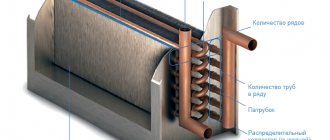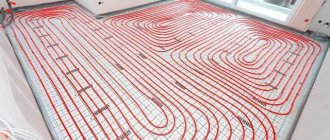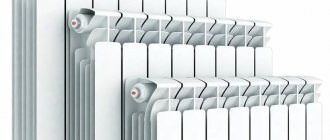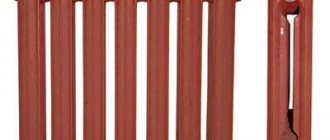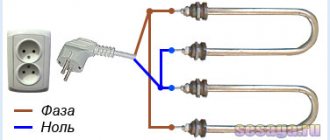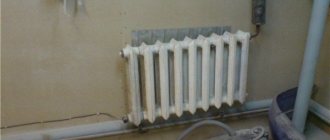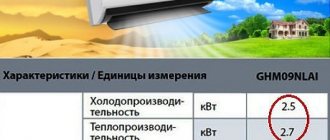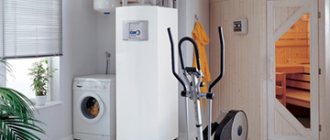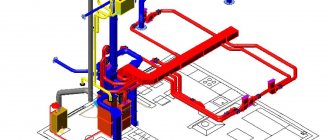Efficiency of using air heaters instead of heating radiators
The coolant circulating through water heating radiators transfers thermal energy to the surrounding air through thermal radiation, as well as through the upward movement of convection flows of heated air and the entry of cooled air from below.
The heater, in addition to these two passive methods of transferring thermal energy, drives air through a system of heated elements with a much larger area and intensively transfers heat to them. Assessing the efficiency of heaters and fans allows for a simple calculation of the cost of installed equipment for the same tasks.
An example of heating a vehicle maintenance service room with air heaters.
For example, it is necessary to compare the cost of radiators and heaters for heating the showroom of a car dealership, taking into account compliance with SNIP standards.
The heating main is the same, the coolant is the same temperature, piping and installation can be ignored in a simplified calculation of the costs of the main equipment. For a simple calculation, we take the known norm of 1 kW per 10 m2 of heated area. A hall with an area of 50x20 = 1000 m2 requires a minimum of 1000/10 = 100 kW. Taking into account a margin of 15%, the calculated minimum required heating capacity of heating equipment is 115 kW.
When using radiators . We take one of the most common bimetallic radiators Rifar Base 500 x10 (10 sections), one such panel produces 2.04 kW. The minimum required number of radiators will be 115/2.04 = 57 pcs. It’s immediately worth considering that placing 57 radiators in such a room is unreasonable and practically impossible. If the price of a device for 10 sections is 7,000 rubles, the cost of purchasing radiators will be 57 * 7000 = 399,000 rubles .
When heating with air heaters . To heat a rectangular area in order to distribute heat evenly, we select from 5 Ballu BHP-W3-20-S water heaters with a capacity of 3200 m3/hour each with a similar total power: 25 * 5 = 125 kW. Equipment costs will be 22900*5 = 114,500 rubles .
The initial cost of heaters is almost 4 times less than the purchase of efficient bimetallic radiators.
When comparing the installed capacities of radiators and heaters by price, it is necessary to take into account in the calculation that one of the main indicators of standard heaters is the productivity of warm air. With a ceiling height of 6 meters in our example, the volume of the exhibition hall will be 1000 * 6 = 6,000 m3. Five air heaters with a capacity of 3200 m3/hour will refresh the air in the hall almost three times per hour, which will ensure its normal quality for workers and visitors not only in temperature, but also in composition.
The main area of application of air heaters is the organization of heating of rooms with large spaces for air movement:
- production workshops, hangars, warehouses;
- gyms, exhibition pavilions, shopping centers;
- agricultural farms, greenhouses.
Compact devices that allow you to quickly heat air from 70°C to 100°C, easily integrated into the overall automatic heating control system, are advisable to use in buildings with reliable access to coolant (water, steam, electricity).
The advantages of water heaters are:
- High profitability of use (low cost of equipment, high heat transfer, ease and low cost of installation, minimal operating costs).
- Fast air heating, ease of change and localization of heat flow (thermal curtains and oases).
- Reliable design, ease of automation and modern design.
- Safe to use even in high-risk buildings.
- Extremely compact dimensions with high heating output.
The disadvantages of these devices are related to the properties of the coolant:
- At temperatures below zero, the heater is easy to freeze. If water is not drained from the pipes in time, they can break if disconnected from the main line.
- When using water with a large amount of impurities, the device can also be damaged, so using it at home without filters and connecting it to a central system is impractical.
- It is worth noting that air heaters dry out the air greatly. When used, for example, in a showroom, humidifying climate control technology is required.
Selecting and connecting a water fan heater: device, review of the best models and their cost
The centralized heating system has one drawback: radiators heat the air too slowly to a comfortable temperature. In order to speed up this process, devices have been developed - water fan heaters. They are connected to the heating system, concentrate the heat and disperse it throughout the room.
What are water heaters?
Heating equipment of this type is not used in everyday life. It is intended for industrial use and is most effective over large areas. But if necessary, low-power water fan heaters can be installed in dachas and private homes. The devices have a simple design and are easy to make with your own hands.
How it works: principle of operation and device
A water fan heater is an inexpensive device, the main elements of which are:
- electric motor;
- fan;
- frame;
- Control block.
The operating principle of this equipment is in many ways similar to the operation of a heat gun. It differs in that in the second case the air is heated by special heating elements. And in water fans, the heat source is the pipes of the heating system with hot water. In this regard, the devices are distinguished by minimal energy consumption, which is required only for the operation of the fan.
What is it for: areas of application
The scope of application of water fans is extremely wide. They are used to heat rooms for various purposes:
- trading floors;
- storage facilities;
- production workshops;
- greenhouses and conservatories;
- hangars;
- garages;
- car washes and service stations.
Installation of equipment is possible wherever communications of the centralized heating system pass.
The correct choice of location for installing the devices is of great importance. They cannot be mounted in close proximity to walls, since in this case air intake through the rear panel of the device will be difficult.
Correct installation of a water heater
Wall mounting of a water fan heater using a factory console consists of several stages.
- The console is placed in the selected installation location, and the location of the holes for the self-tapping screws (screws) is marked on the wall.
- Drill holes using a drill with a drill bit of the appropriate diameter.
- Mount the console on the wall.
- Metal hoses are installed on the pipes of the device for connection to the heating system.
- Hang the fan heater on the console, securing it with two bolts.
- Connect metal hoses to the pipes of the heating system.
Reviews of fan heaters with a water heat source: pros and cons
According to consumer reviews, water fan heaters have their advantages and disadvantages.
Advantages:
- simplicity of design;
- no need for regular maintenance;
- efficiency;
- quick installation;
- low noise level;
- affordable price;
- long service life.
Flaws:
- To connect to the heating system you need instructions, tools and components.
Manufacturers and popular models: ranking of the best and prices
Water fan heaters are produced by companies specializing in the production of household and industrial heating equipment. Models differ in power, performance, and number of functions.
BALLU BHP-W-30
A reliable device from a manufacturer that produces a wide range of climate control equipment. The model is designed for heating rooms up to 300 m2. The device is connected to a water heating circuit and provides thermal power of up to 45.6 kW. The equipment is equipped with a three-speed electric motor, a double-row heat exchanger made of copper and aluminum.
A powerful fan ensures the distribution of air flow over a distance of 25 m from the installation site of the device. The package includes a bracket for mounting to the wall. The body of the device is made of polypropylene, resistant to mechanical stress.
Specifications:
- productivity - 5300 m3/hour;
- power consumption - 420 W;
- dimensions - 820x960x350;
- weight - 22 kg.
The device is widely used for heating warehouse and industrial premises, workplaces in high-traffic areas. The manufacturer provides a 2-year warranty on its product. Average price 17990 rub.
Fan Teplomash KEV-34T3.5W2
produces several models of water fan heaters of different power. All devices are distinguished by high build quality and have proven themselves to be reliable and high-performance equipment. In the warm season they are used as fans to cool rooms, in the cold season they are used as heating devices.
Advantages of KEV-34T3.5W2:
- low noise engine;
- reliable axial fan;
- durable body made of galvanized steel;
- a protective grille is mounted on the rear panel;
- built-in thermostat providing protection against overheating.
On the front panel of the device there are adjustable blinds, with the help of which the direction of air flow is changed. The manufacturer offers as an additional option a mixing unit and remote control of the operation of the device using a remote control. The recommended installation height with the air stream directed downwards is 4-7 m. Three operating modes:
- fan;
- 50% heating;
- 100% heating.
Specifications:
- power consumption - 130 W;
- noise level - 48 dB;
- air flow power - 1900 m3/hour;
- dimensions - 475x305x400 mm;
- weight - 6.5 kg.
Average price 18,700 rubles.
Teplomash KEV MW
Another popular model from a well-known heating equipment manufacturer. Water heaters of the MW series are designed for installation vertically, horizontally or at an angle of 30° using the included brackets. When installed horizontally, the height is limited by the length of the jet supplied by the fan heater at medium power.
The device is equipped with adjustable blinds and is controlled remotely using a remote control. The mixing unit is not included in the package and must be purchased separately. Teplomash produces two series of devices: TW and MW. The models differ in the case material: TW has a metal case, and MW has a plastic one. Product warranty 1 year.
Specifications:
- heating power - 27 kW;
- jet length - 25 m;
- dimensions - 876x534x780 mm;
- weight - 28.2 kg.
Average price 19910 rub.
Fan heater Volcano VR1 AC
VR1 AC is one of the best fan heaters with a water heat source. It features high thermal output and low operating costs. Widely used for heating workshops, gyms, shopping centers, greenhouses.
The efficiency of the equipment is ensured by the presence of an axial fan with aluminum blades. The equipment is characterized by a low noise level and the ability to regulate air flow in any operating mode. The device is equipped with a new generation electric motor with an energy consumption of 2800 W.
The model attracts not only with its high performance. It has an impressive design, made in non-marking gray and black colors. The case is made of ABS plastic, has an easy-to-clean surface that is not exposed to ultraviolet radiation. The manufacturer provides a lifetime warranty on the body of the device.
Water fan heaters from Volcano have a system of connection to the water circuit, patented by the manufacturer, which ensures precise fit of parts. Adjustable blinds are designed in such a way that they successfully withstand powerful air flow. The design of the front panel includes innovative fastenings for blinds, guaranteeing stability of their positioning and precise adjustment.
Specifications:
- thermal power - 5-30 kW;
- three fan speeds;
- remote control;
- productivity - 2800/3900/5300 m3/hour;
- noise level - 40/51/56 dB;
- dimensions - 700x355x700 mm;
- weight - 27.5 kg.
Average price RUB 21,465.
Volcano VR2 AC
The Polish industrial water fan heater VR2 AC is an improved model of the VR1 AC device. It features easy and quick installation. Thanks to a special console, the device can be rotated at any angle in the range of 0-120°.
When assembling the control unit, parts from the world's leading manufacturers were used. Connection to the coolant is made using flexible pipes with a cross-section of ¾ inches. The manufacturer offers additional BASIC automation equipment, including:
- valve with servo drive;
- fan speed controller;
- thermostat.
There is another configuration option: PRESTIGE, which, in addition to what is listed in BASIC, includes a programmable temperature controller.
Specifications:
- 2 rows of heaters;
- productivity - 4850 m3/hour;
- thermal power - 8-50 W;
- maximum horizontal jet length - 22 m;
- maximum vertical jet length - 11 m;
- dimensions - 700x355x700 mm;
- weight - 29 kg.
Average price RUB 31,804.
Water fan heater Dome TPV-15
Water fan heaters of the Izhevsk electromechanical TPV series are reliable and high-performance devices, characterized by power, performance, and a set of options. Model TPV-15 can be used for heating residential and industrial premises. The device is equipped with two powerful heating elements that are not in direct contact with air and therefore do not burn oxygen.
Overheating protection is implemented via a built-in thermostat. There is two-stage power regulation. The case is impact-resistant and coated with a layer of heat-resistant powder paint. The device can be installed vertically, horizontally and at an angle of 30°. A distinctive feature of the equipment is the electric motor from the German company EBM.
Specifications:
- temperature control in the range 0-40°C;
- thermal power - 15 kW;
- productivity - 3500 m3/hour;
- dimensions - 555x655x310 mm;
- weight - 28 kg.
Average price 14,716 rubles.
Which manufacturer and which type is better to choose: TOP-3
Leading manufacturers of water fan heaters are presented in a review of the best models of this climate control equipment. These are BALLU, Volcano, IEMZ “Dome”.
What to consider when choosing a device?
The main criteria for choosing a water fan heater:
- maximum installation height;
- length of horizontal and vertical air stream;
- power;
- performance;
- control type.
When installing in public spaces, the design of the device matters. It should be harmoniously combined with the surrounding interior.
3 best models
Of these, three of the most successful models can be identified:
- BALLU BHP-W-30;
- Volcano VR2 AC;
- Teplomash KEV MW.
These fan heaters are distinguished by the possibility of remote control, precise positioning of the blinds, and ease of installation. The equipment has received a lot of positive reviews and has a stylish design. Price range - 18-31 thousand rubles.
Price
Among the best models of water fan heaters are relatively inexpensive devices:
- BALLU BHP-W-30 — 17,990 rubles;
- Teplomash KEV-34T3.5W2 - 18,700 rubles;
- Teplomash KEV MW - 19,910 rubles;
- Volcano VR1 AC - RUB 21,465;
- Volcano VR2 AC - RUB 31,804;
- Dome TPV-15 — 1716 rub.
The variation in cost is explained by the different characteristics and additional functionality of the devices. The price will also depend on which store you purchase the device from.
Where to buy a water fan heater?
In Moscow
- Online store "M.Video", 8-800-200-777-5.
- Online store "TECHPORT".
- DAIRE online store, +7 (3412) 998-095.
In St. Petersburg
- Online store "Kuvalda.ru".
- Online store “220 Volt”, 8 (800) 333-9-220.
- Poisk Home online store.
A review of the best models of water fan heaters will help you choose equipment of the required power from a reliable manufacturer. The installation instructions will tell you how to install the device yourself.
Mar 25, 2018ventsyst
Device and principle of operation
The design of the main element of the heater - the heat exchanger.
The heater is capable of raising the temperature of the air flow passing through it by 110 degrees using incoming air of negative temperature (up to -25°C). The connection of such devices to the heat supply source occurs before the collector of the internal heating networks, so as not to reduce the temperature of the system coolant. Electric and steam heaters are connected in parallel, and water heaters are connected in series.
The operating principle of a water heater is as follows:
- Water from the heating main with a temperature from +80°C to 180°C enters a block of thermal elements located horizontally. Each thermal element is a steel, aluminum, bimetallic or copper tube.
- The tubes heat the air inside the device.
- A fan built into the unit takes air from the room or from the street and blows it through the thermal elements, ensuring the movement of hot air into the room.
Types of heaters
There are several types of air heaters used in different areas and conditions.
Let's take a closer look at them:
Mermen
The most common group of devices, characterized by high efficiency, safety and ease of operation. They use hot water as a coolant, coming from the central heating network, hot water supply or from their own boiler. A water heater for fresh air ventilation is the most convenient and economical solution, allowing you to perform the assigned tasks with minimal maintenance or repair costs. The only drawback of the device is the need to connect to the coolant supply system, which creates certain difficulties at the installation stage and prevents quick transfer to another location.
Steam
Steam devices are complete analogues of water devices and in practice differ from them only in the type of coolant. The only difference between steam devices is the greater thickness of the tube walls - 2 mm versus 1.5 for water ones. This is due to the high pressure in the system, requiring reinforced channels for circulation. Otherwise, the devices are identical and have the same operating rules and requirements.
Electrical
An electric heater for supply ventilation does not require a coolant supply, since the heating source is electric current. Connecting such devices is much simpler, which makes them mobile and easy to use, but high energy costs limit the use of this group. Most often, they are installed for local heating when performing one-time work, and are used as emergency or temporary heat sources.
Installation and testing of water heaters
Before sale, all water heaters undergo factory testing under a pressure of 16 atm for leaks.
When placing a water heater in a cold room (below +5°C), it is recommended to use glycol water mixtures as a coolant.
The presence of a clean air filter in front of the heat exchanger is a guarantee of proper operation of the automation and no risk of equipment failure.
After installing and connecting the water heater, it is necessary to empty the system of excess air and conduct hydraulic tests for the tightness of connections and joints.
Water heater calculation
Calculation of the heater power required to heat a particular room is carried out taking into account such data as:
- The volume (mass) of supply air that needs to be heated.
- Initial (external) temperature of air masses.
- The target temperature to which the air must be heated before being supplied to the room.
- Temperature regime of the coolant.
The heater is calculated based on the heating surface area and the required power. Each operation has its own formula. The heater power can be calculated only taking into account real data in specific conditions, among which the most important are:
- connection method (to the central heating network or boiler room);
- strapping method.
Calculation of heater power
Qt – heater heat power, W; L – air flow, m³/hour ρair – air density. The density of dry air at 15 °C at sea level is 1.225 kg/m³; air – specific heat capacity of air equal to 1 kJ/(kg∙K)=0.24 kcal/(kg∙°C); tin – air temperature at the outlet of the heater, °C; tnar – outside air temperature, °C (air temperature of the coldest five-day period with a probability of 0.92 according to SP 131.13330.2012)
Heater power calculator
Air flow, m³/hour: Air density, kg/m³: Specific heat capacity of air, kJ/(kg × K): Air temperature at the air heater outlet, °C: Outside air temperature, °C:
Coolant flow for the heater G - water flow for heat supply to the heater, kg/h; 3.6 - conversion factor W to kJ/h (to obtain flow rate in kg/h); Qt – heater heat power, W; sv – specific heat capacity of water equal to 4.187 kJ/(kg∙K)=1 kcal/(kg∙°C); tpr – coolant temperature (straight line), °C; trev – coolant temperature (return line), °C.
Coolant flow calculator for heater
Thermal power of the air heater, W: Specific heat capacity, kJ/(kg × K): Coolant temperature (forward line), °C: Coolant temperature (return line), °C:
Air heating process diagram
You can determine the required heater power using special diagrams. The amount of energy required (Joules) to heat 1 kilogram of air is produced using the i-d diagram of moist air. The calculation is made under the condition that the air heating process occurs at d = const (with constant moisture content). Next, taking into account the calculated air flow rate and the conversion of units (J/s to kW), the heater power is determined. i–d diagram of humid air
To obtain accurate data, you can use online calculators, with which you can find out the power indicator by indicating performance and temperature. Since the performance of the installation may decrease as a result of gradual wear, it is recommended to include a power reserve of 5 to 15% in the calculation.
Brief overview of modern models
To get an impression of the brands and models of water heaters, let’s look at several devices from different manufacturers.
No. 1 – KSK air heaters
Heaters KSK-3, produced at the company T.S.T.
The model range of domestically produced KSK water heaters includes 2/3/4-row devices that differ in performance and size
Specifications:
- coolant temperature at the inlet (outlet) – +150 °C (+70 °C);
- inlet air temperature – from -20 °C;
- working pressure – 1.2 MPa;
- maximum temperature – +190 °C;
- service life – 11 years;
- working resource – 13,200 hours.
Actual heater power
8. Calculation of the actual thermal power of the selected heater(s) for supply ventilation. q (W) = K • F • ((t in + t out)/2 - (t start + t end)/2)) or, if the temperature difference is calculated, then q (W) = K • F • average temperature pressure K—heat transfer coefficient, W/(m²•°C); F - heating surface area of the selected heater (accepted according to the selection table), m²; tin—water temperature at the inlet to the heat exchanger, °C; tout—water temperature at the outlet of the heat exchanger, °C; t start — air temperature at the inlet to the heat exchanger, °C; t con is the temperature of the heated air at the outlet of the heat exchanger, °C.
An example of selection and calculation of a KSk air heater. Step-8
Select a suitable KSk heater for heating 16,000 m³/hour from a temperature of -25°C to +23°C. The coolant is hot water with a schedule of 95°C at the inlet to the air heater, 60°C at the outlet. 8. Calculation of the actual heating capacity of air heaters KSk number 11, with the specified and calculated values, is carried out using the following formula for calculating the heater power: q (W) = 55.82 • 57.1 • ((95 +60)/2 - (-25 +23) /2)) = 250205 W - for heater KSk 2-11 q (W) = 48.97 • 86.2 • ((95 +60)/2 - (-25 +23)/2)) = 331365 W - for heater KSk 3 -11 q (W) = 43.91 • 114.2 • ((95 +60)/2 - (-25 +23)/2)) = 393640 W - for heater KSk 4-11 55.82, 48.97, 43.91 - heat transfer coefficients of heaters, W/(m²•°C); 57.1, 86.2, 114.2 - heating surface area of air heaters, m²; 95 — water temperature at the inlet to the heat exchanger, °C; 60 — water temperature at the outlet of the heat exchanger, °C; -25 — air temperature at the inlet to the heat exchanger, °C; 23 — temperature of heated air at the outlet of the heat exchanger, °C.
Water heaters for fresh air ventilation
All available types of heating devices for ventilation are inferior or, at best, are similar in their technical characteristics to water-based devices.
The main area of use of air heaters is buildings or premises in which, for various reasons, it is not possible to install radiators. For example, with large volumes of rooms, radiators simply cannot cope; on the contrary, it will be the most effective. The most rational location of water heaters is the supply ventilation line, since it is not practical to heat the exhaust flow.
heating of the supply jet is actively , used to preserve the existing heat in the room. If a fresh stream is transported through a long line of air ducts, then condensation will accumulate on them without heating the air, which will create a lot of operational problems. To solve all these issues, water air heaters are used.
Water air heater: operating principle and design
The most common type are. They replaced plate structures, which were less easy to maintain and required periodic maintenance in a rather labor-intensive manner.
- View cart Add to cart / Details
Heater KSK 4-1
8 100 ₽PostponePostpone ⚖ Compare
- View cart Details
- View cart Details
- View cart Add to cart / Details
Heater KSK 4-2
9,300 ₽PostponePostpone ⚖ Compare
Heater KSK 4-3
10 550 ₽PostponePostpone ⚖ Compare
Heater KSK 4-4
11,770 ₽PostponePostpone ⚖ Compare
Heater
The main element of the heater is a steel tube , the outer surface of which is coated with aluminum fins. These fins serve as a heat-transfer surface, the total area of which is quite large. At the same time, the total outer diameter of the tubes (including fins) is 37 mm, and the tube itself is 16 mm, so the depth of the fins is relatively small and does not pose the risk of filling with dirt, dust or other foreign materials that reduce heat transfer. The distance between the fins is 2.8 mm, which allows you to retain heat even with intense airflow, making the device highly efficient.
Tubes
The tubes are installed in a flat rectangular frame in 2, 3 or 4 rows. The distance between the axes of the tubes promotes maximum heat transfer from their surface. The air flow is supplied using an axial or radial fan, it depends on the installation location of the device and the specifics of its operation.
Installation
To install the heater, the housing (frame) has several oblong mounting holes on flange mounts . With their help, devices can be installed in a system of air ducts, in openings or other supporting structures. Sometimes a separate installation is used when the device serves a room of a certain size and is not built into the overall heating or ventilation system.
Features of the choice of air heaters and their classification
The heater is installed in ventilation systems under the guise of individual elements, or in combination with a monoblock design. His choice is influenced by factors such as:
- Room size;
- Ventilation power;
- Climatic conditions.
Based on these data, it is already possible to select a ventilation heater for specific requirements. Heaters can be divided into 2 types:
Electric heater for fresh air ventilation
Electric heaters are the simplest option. It does not require complex communication lines, since it only requires a power source to operate. To ensure more efficient heat exchange, heating elements are built in, which contribute to the conversion of electricity into heat. The principle of operation is such that the air coming from the street passes through the heating element, in which it is heated and only after that it passes into the room. This option is effective in areas of no more than 150 m2, since its use in larger spaces is impractical. A significant disadvantage is the high energy consumption;
Water heater for fresh air ventilation
Water heaters are a practical and reliable option that is more suitable for rooms over 150 m2. They do not require any maintenance and are considered cheap to use. Their effectiveness is interconnected with the presence of automation in control. With their help, you can easily equalize the air temperature, as they are equipped with a thermostat. The principle of operation is based on the fact that air enters through a special air intake mesh and passes to filters, where it is cleaned of dust and harmful substances. Then it passes into the heater, where it is heated by the heat that comes from the main water.
Differences in air heaters by tube type
Heating heaters may differ in the type of tubes used to transfer heat. The following models of such devices are distinguished:
Attention ! Caloriferous smooth-tube heating is the least efficient, but the cost of such products is noticeably lower.
Differences in air heaters by installation method
Household and industrial air heaters can have the following placement options:
- Wall.
- Ceiling.
- Floor.
Some models can also be built into a forced ventilation system, which allows you to maximize the efficiency of this heating method.
Connection diagram and control
Electric heaters must be connected in compliance with all safety requirements. The connection diagram for the electric heater is as follows: when you press the “Start” button, the engine starts and the heater ventilation is turned on. At the same time, the engine is equipped with a thermal relay, which, if there is a problem with the fan, instantly opens the circuit and turns off the electric heater. It is possible to turn on the heating elements separately from the fan by closing the blocking contacts. To ensure rapid heating, all heating elements are turned on simultaneously.
To increase the safety of the electric heater, the connection diagram includes an emergency indicator and a device that prevents the heating elements from turning on when the fan is turned off. In addition, experts recommend including automatic fuses in the circuit, which should be placed in the circuit together with the heating elements. But installing automatic machines on fans, on the contrary, is not recommended. The heater is controlled from a special cabinet located near the device. Moreover, the closer it is located, the smaller the cross-section of the wire connecting them can be.
When choosing a water heater connection diagram, you need to focus on the placement of mixing units and units with automation. So, if these units are located to the left of the air valve, then a left-hand design is implied, and vice versa. For each version, the location of the connecting pipes corresponds to the air intake side with the installed valve.
There are a number of differences between left and right placement. So, with the right-hand version, the water supply tube is located at the bottom, and the “return” tube is located at the top. In left-sided circuits, the supply pipe enters from the top, and the outflow pipe is located at the bottom.
When installing a heater, it is necessary to install a piping unit necessary to monitor the performance of the device and protect it from freezing. Piping nodes are the reinforcement frames that regulate the flow of hot water into the heat exchanger. Piping of water heaters is done using two- or three-way valves, the choice of which depends on the type of heating system. Thus, in circuits heated by a gas boiler, it is recommended to install a three-pass model, while for systems with central heating, a two-pass model is sufficient.
Controlling a water heater involves regulating the thermal power of heating devices. This is made possible by the process of mixing hot and cold water, which is carried out using a three-way valve. When the temperature rises above a set value, the valve releases a small portion of cooled liquid into the heat exchanger, which is taken at the outlet.
To increase the efficiency of the system, it is recommended to include a circulation pump in the connection diagram. The device is installed at the outlet of the heat exchanger, which allows it to work with already cooled glycol solution or water.
In addition, the installation diagram of water heaters does not provide for the vertical arrangement of inlet and outlet pipes, as well as the location of the air intake at the top. Such requirements are due to the risk of snow getting into the air duct and melt water flowing into the automation. An important element of the connection diagram is the temperature sensor. To obtain correct readings, the sensor must be placed inside the air duct in the blowing section, and the length of the flat section must be at least 50 cm.
Connecting an electric heater
In electrical types, the main parameter is the power in kW; accordingly, it requires caution and compliance with safety precautions when connecting it. This option uses a control unit that is capable of controlling the temperature in the room. When the indoor temperature is below the set temperature, the heater automatically turns on. Using a thermostat, you can maintain the set temperature and be protected from heating the device over 140 degrees.
The way it works is that when the “Start” button is pressed, the engine and heater ventilation start. A thermal relay at a certain current is connected to the motor. In case of problems with ventilation, the thermal relay is triggered, after which the power circuit is opened.
When the heater fan is on, you can turn on the heating elements by closing the blocking contacts. The heating elements are turned on using the “Start” button. At this time, the intermediate starter is turned on, which activates a powerful starter, which turns on the heating elements through its contacts. For the fastest possible heating, all heaters turn on immediately.
- For fire protection, the circuit includes the following elements:
- Thermal relay that protects the engine when stopped;
- Protection against switching on without a fan;
- Thermal relay, which protects the heater housing from overheating. While the thermostat is activated, the fan will continue to operate and cool it down.
The circuit can be supplemented with a starter power-on indicator and an emergency indicator. In addition, it is advisable to install an automatic switch on the circuit that powers the heating elements, as well as a more powerful circuit breaker at the input of the device. Circuit breakers should not be installed on fans.
To control the heater, a control cabinet is installed, which should be located near the heater. The shorter the distance, the smaller the wire cross-section can be used.
Installation Tips
Heaters with sensors in the greenhouse maintain the desired temperature.
The water heater is installed in rooms connected to the central heating main. When installing yourself, you should follow the recommendations of specialists:
- The diagonal of the heater depends on the bending characteristics of the channels, the type of damper and structural elements.
- To protect the heater from freezing, installation is carried out in rooms with a temperature not lower than 0 degrees.
- Before installation, it is necessary to inspect the plates and tubes for integrity.
- Weld-on flanges are easiest to connect end-to-end.
- Direct-flow air vent valves are located at the top of the outlet and supply manifolds.
- The joints between the device and the ventilation system are sealed.
- Wall-mounted models are installed by fastening the console with two self-tapping screws.
If you have no experience connecting and tying the system, it is better to entrust the work to specialists.
